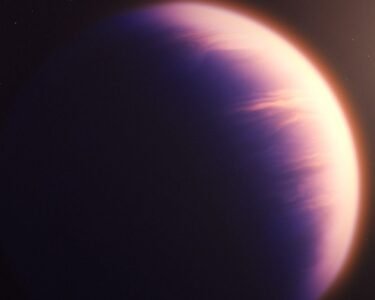This NASA/ESA photograph of the Hubble Space Telescope shows the serenely drifting jellyfish galaxy JW39. This galaxy, one of many jellyfish galaxies Hubble has observed over the past two years, lies around 900 million light-years away in the constellation Coma Berenices.

What are the effects of galaxy clusters on the shape and gas content of galaxies?
Although it seems serene, this jellyfish galaxy is actually drifting in a galaxy cluster, which is an extremely dangerous environment. The gravitational attraction of larger companions frequently warps galaxies in galaxy clusters, twisting them into a variety of designs.
Additionally, a searingly hot plasma known as the intrascluster medium dominates the area between galaxies in a cluster. Despite the extreme thinness of this plasma, galaxies moving through it have an almost current-like sensation, and this interaction can deplete galaxies of star-forming gas.
What Phenomenon Creates the Distinctive Trailing Tentacles in Jellyfish Galaxies?
Ram-pressure stripping, or the interaction between the intracluster medium and the galaxies, is what causes the jellyfish galaxy’s trailing tentacles. As JW39 traveled through the cluster, the intracluster medium’s pressure sucked away gas and dust, creating long trailing ribbons of star formation that now extend away from the galaxy’s disk.
What is the impact of harsh environments on star formation in drifting jellyfish galaxy?
Astronomers used Hubble’s Wide Field Camera 3 to investigate these trailing tendrils in great detail because they represent a particularly hostile environment for star formation.
Surprisingly, researchers found little difference between star production in the galaxy disk and star formation in the ‘tentacles’ of drifting jellyfish galaxies.
Hubble Space Telescope Captures Drifting Jellyfish Galaxy That are Located Over 900 Million Light-Years Away
The drifting jellyfish galaxy JW39, located in the constellation Coma Berenices and situated over 900 million light-years away, has been captured by NASA/ESA’s Hubble Space Telescope.
This peculiar galaxy finds itself adrift within a galaxy cluster. In such clusters, the gravitational forces exerted by larger neighboring galaxies often cause distortions, resulting in galaxies assuming various shapes.
Furthermore, the space between galaxies within the cluster is influenced by a scorching-hot plasma known as the medium.
While this plasma may be tenuous, galaxies moving through it experience its effects akin to a swimmer battling against a strong current, resulting in the stripping away of their star-forming gas.





